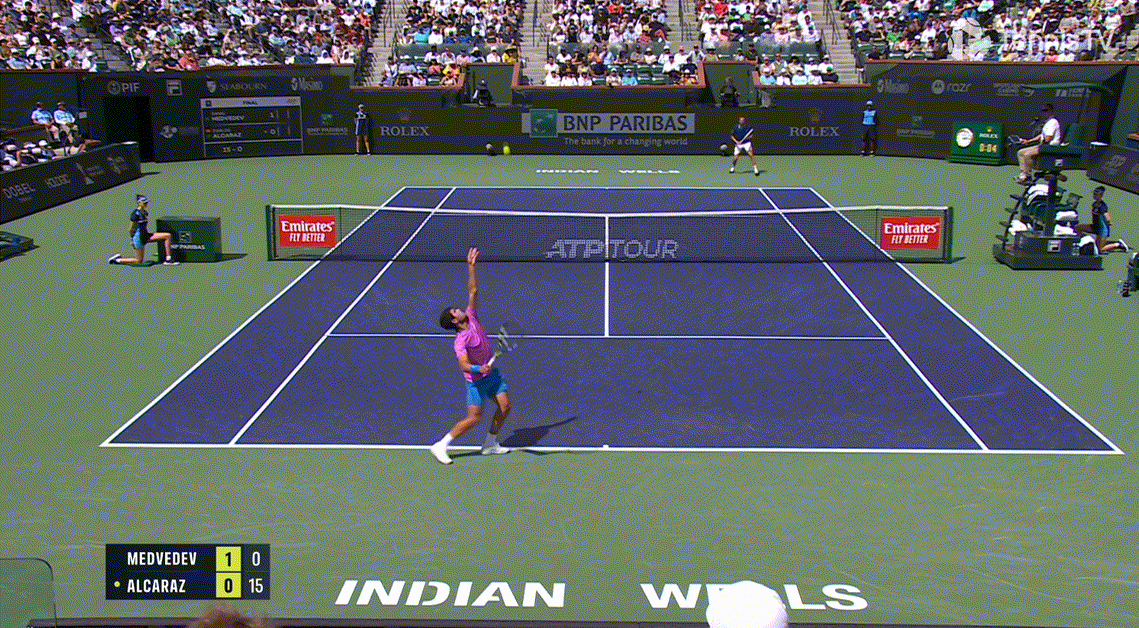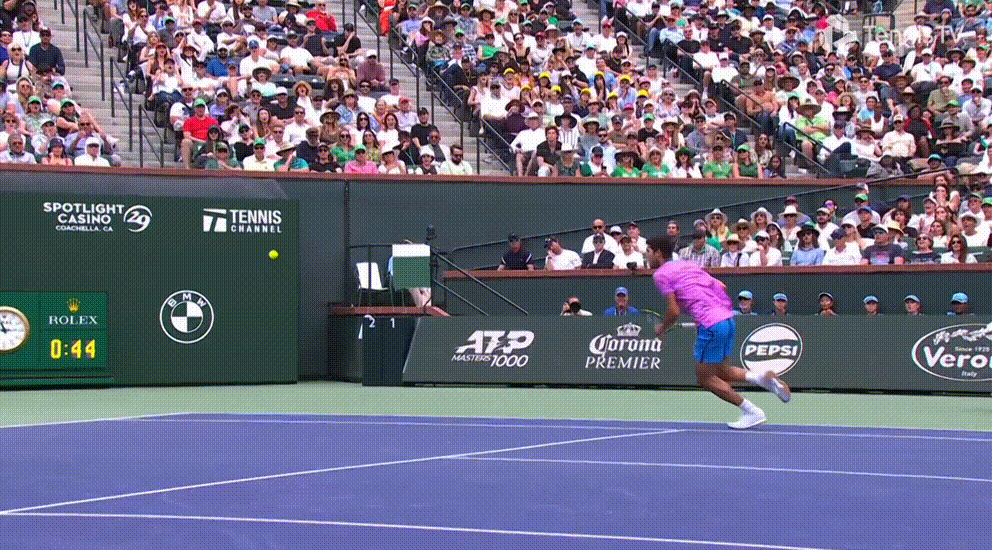Alcaraz vs Medvedev: Indian Wells Final Recap
heavy forehands — defensive slice — return positions
In a repeat of last year’s final, Carlos Alcaraz defeated Daniil Medvedev 7/6 6/1 to defend his BNP Paribas title and get his season back on track. Alcaraz now leads Medvedev 4-2 in their H2H.
Last year Alcaraz exposed Medvedev’s deep return position with an array of serve-volley and drop shots. Here is the Russian’s return position on the first point of last year’s encounter.
Alcaraz is the ultimate player when given time; he can fabricate many tailored solutions when in possession of that commodity.
However, as he did against Sinner in the final of the Australian Open, the 2024 version of Medvedev has made a concerted effort to adopt a more aggressive return position and rush his rivals.
Medvedev started the match returning ~1-2 metres behind the baseline. As a result, the Russian was able to rush Alcaraz into errors early on.
This closer return position also counteracts the serve-volley option. Alcaraz tried it in the opening game, but notice how he is forced to volley from behind the service line; the return comes back faster, and Medvedev is already well positioned to retrieve the volley.
“Even though Medvedev hasn’t done anything special in this game, just the different look, the unexpected look, has perhaps unsettled Alcaraz.”
— Tennis TV
Medvedev kept an amazing depth on his groundstrokes in this first return game — especially with his backhand crosscourt — and he forced two backhand errors from deuce to earn the break as Alcaraz tried to hold the baseline and go toe-to-toe. This is the key pattern for the Russian in this matchup; it pits his best shot (his backhand crosscourt) against Carlos’ worst.
Yet, despite Medvedev’s best attempts to steal time, Alcaraz found other ways to buy it, adding height and spin to both wings and sprinkling in doses of slice off his backhand in a bid to take the ball out of the Russian’s metronomic hip-height hitting zone. It was the most Rafa-esque forehand performance I can remember from Alcaraz.
Carlos opted out of the linear battle and started to play the ball above the shoulders and below the waist of Daniil. If there is a worthy criticism of Medvedev’s forehand, it is his lack of ability to generate power and spin outside his hip strike zone.
This lack of pace and spin injection means a skilled defender like Alcaraz can actually bait Medvedev into the net in a favourable manner. Federer used to do this to Roddick’s backhand. Chip low and short:
Even though Alcaraz had racked up quite the body count of unforced errors through the first five games, to me, this was a tactically clear and disciplined Alcaraz; the execution was off by a hair, but it was only a matter of time.
He also found a drop shot to break back.
Alcaraz often plays his droppers in the opposite direction his opponent is split-stepping.
Medvedev recognises this drop shot well before his feet hit the ground off his split step, but he’s powerless to do anything about it. He’s just floating helplessly to the right while Alcaraz feathers it over the net to his left. Notice that he is also gliding right and slightly backwards. The fear of the Alcaraz forehand compliments his drop shot so well as opponents are often recovering on a backward V in anticipation of chasing down a drive forehand.
“You know, some players never find the solution in a match. Some take a while. Alcaraz took one, maybe two return games? Changed his return position, made the adjustments, and here he is at three-all.”
— Tennis TV
In the ninth game Alcaraz won the point of the tournament. It wasn’t just the miraculous court coverage that was impressive — that much is taken for granted with him now — but the minute sleight-of-hand adjustments made in real time while sliding at end-range are sui generis. Like many greats, Alcaraz’s game adds to the taxonomy of shots that seem possible. Check it out below.
It’s difficult to see in this gif, but as Alcaraz is running back for this defensive squash shot, he flips the grip around farther in his hand to something so extreme it’s kind of close to semi-western (but using the other side of the strings). Instinctively, he knows that such a grip can be played with a straight arm (to give him maximum reach) while still having the ability to fan the racquet under the ball and slice it backwards for a high defensive lob.
A video explanation from HQ:
Medvedev had half a chance at 5-4 with Alcaraz serving at 15-30 to stay in the set. From there, the Spaniard reeled off three booming serves; two went unreturned, and the third was crushed with a plus-one forehand.
Then at 6-5, following two more first-serves — that’s five in a row for Carlos across the two games — Medvedev dropped back on return. Alcaraz won his first serve-and-volley point, feathering a perfect drop volley. It was 2023 all over again:
That’s ridiculous feel. Medvedev knows exactly where this volley is going, but it’s just hit too well. Alcaraz at his best is a tactical shapeshifter.
The Spaniard has been guilty of being trigger happy in his career – any 20-year-old with the toys his game possesses would be equally tempted — but the semifinal win over Sinner, and this display against Medvedev, were perfect advertisements of how his game is really a delicate act of counterbalancing irresistible power with irresistible finesse. That he manages to do so on the game’s biggest stages is as much a testament to his game IQ as it is his bodily talent.
Here’s another example.
Alcaraz is unusually exceptional at defending his backhand with short slice.
In fact, there’s only two guys who do it as well, and they both have single-handers (Grigor Dimitrov and Dan Evans).
There’s a lot of subtle reasons this low crosscourt slice is a boon to players who can play it. Firstly, there’s more reach when you take your left hand off, but you can also hit it slower than a two hander, so it buys Carlos more time to recover. On Medvedev’s end, he’s now dealing with a ball that is low and slow with backspin. He can try and meet it early for a volley, but the beauty of that slice is that you can feather it to land short — shorter than you could a stretched double-hander — and this then forces the opponent to let it bounce as Alcaraz continues to recover. Medvedev stops in his tracks and hits a backhand, but he’s forced to hit up with Alcaraz well recovered; he can either hit it straight back to Alcaraz’s backhand, or go over the high part of the net (and short length of the court) to hit it down the line and into the Alcaraz forehand. It may not look like it, but once that slice is made, Carlos is in the driver’s seat.

It didn’t take long to see the exact play unfold again, this time at 4-1:
The second set was peak Alcaraz. The forehand was humming in all facets, and Medvedev simply ran out of ideas. The reality is, is that on this court, with Alcaraz playing these tactics, and executing as well as he did, there was nothing the Russian could do.
A look at the final rap sheet:
Alcaraz now heads to Miami with the season looking completely different. One week ago many were worried for the Spaniard. All eyes were on Sinner’s unbelievable level and undefeated start to the season. With Djokovic out and Sinner possibly nursing some bruises from their semifinal encounter, Alcaraz may leave America with a bag of wins and his mojo back.
Miami Q’s started today. I’ll try and squeeze a draw preview in the coming days if time permits.
See you in the comments. HC














I really enjoy the way Alcaraz employs the slice. I think at times there has been a perception that slicing off the backhand is obsolete or less relevant because two-handers can improvise a topspin backhand much more easily than a one-hander could - but the point is that a topspin drive is not always the best answer.
Like your demonstration with the grip - looks like a Gaudio/Guga backhand grip!
Great read as always.
Briefly what were your thoughts on what Alcaraz did against Sinner in the semi? And do you think those tactical changes will be enough against Sinner on a hard court surface that might not suit him as well?